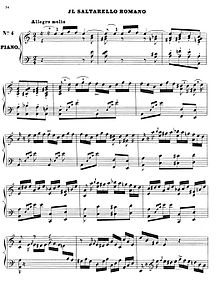Il Saltarello Romano

Il Saltarello Romano is a piano piece by Fanny Hensel from 1841, the motif of which she wrote down during her trip to Italy in Rome. In 1847 she published it as the final piece of the Four Songs for the Pianoforte op. 6 with the Berlin music publisher Bote & Bock . It is the artistic adaptation of the Italian dance Saltarello in virtuoso pianistic manner as a performance piece and is characterized in the fair copy with the additional name Tarantella .
Musical structure
Fanny Hensel's Saltarello (German: "small jump") is in the key of A minor and, in contrast to the three- time measure specified in the Riemann Music Lexicon for this dance (also odd time), is in 2/4 time and in Hensel's fair copy it is 4 / 8 time (both straight bars) written.
After a four-bar introduction , the main dance theme appears, which reappears several times in free form. Its springy sixteenth -note triplets each time lead to rhythmically bouncing triplets (similar to dots), which corresponds to the character of the dance with its jumping figures. Hensel gives Allegro molto (very fast) as the tempo . Triplet garlands run through the whole piece and are a reminiscence of the traditional three-way time for this dance form. The dance-like melody of the piece increases again and again in tonally attractive modulations up to wild outbursts of temperament. The additional term tarantella in Hensel's fair copy also characterizes the impetuous gesture that the composer gave to this ancient dance, whose roots go back to the 14th century. The addition Romano allows the question of a special Roman dance type. The virtuoso piece, 133 bars long, is composed without repetitions, as was common in old dances, and takes about three and a half minutes. Its dynamics increase to a (fortissimo), its tempo at the end to a più presto (even faster), which ends in a spirited arpeggiated final cadence . Sketched during the trip to Italy, the "Saltarello Romano" was completed in 1841.
Songs for the pianoforte
“ Songs without words ” for the piano were a specialty of the siblings Fanny Hensel and Felix Mendelssohn Bartholdy and meant the transfer of human singing to the piano, the instrument that can represent melody and accompaniment at the same time. Instead of the sung word, the pianistic expressive facets of the instrument are exhausted. Hensel composed a duet for tenor and soprano as early as 1832 . Singing with her fingers , a "song (duet) without words" for piano that she wrote in her brother's diary. Fanny Hensel's Four Songs for Pianoforte Opus 6 are also “songs without words”. They are among the few works that the composer published independently before her death, including mainly works of this genre .
Relation to the land of longing and brother Felix Mendelssohn
Fanny Hensel's reference to the fourth movement of her brother Felix's Italian Symphony , which was also composed in the rhythmic style of this dance, can be seen in her saltarello . Hensel's affinity for the land of longing, Italy, was expressed during the Romantic period in particular through her trip to Italy from late August 1839 to mid-September 1840, where she was inspired to write compositions and sketches that she later worked on, including her Saltarello Romano .
Audio samples and score
- YouTube page with a recording by the pianist Daniela Willimek
- Fanny Mendelssohn Hensel: Il saltarello romano. Op. 6, no. 4. (= Classical discoveries. 4.) Elkin, London 1958, OCLC 60711957 .
Web links
- Sheet music for the piece in the IMSLP Petrucci Music Library
- Ute Büchter-Römer: The Italian experience Fanny Hensels, b. Mendelssohn Bartholdy on uni-due.de (PDF, pp. 18 and 28.)
Individual evidence
- ↑ Renate Hellwig-Unruh: Fanny Hensel born. Mendelssohn Bartholdy. Thematic index of the compositions. Edition Kunzelmann, Adliswil 2000, ISBN 3-9521049-3-0 , p. 399.
- ↑ Article Saltarello in: Riemann Musik Lexikon Schott, Mainz 2012, ISBN 978-3-7957-0006-5 , p. 398.
- ↑ Hellwig-Unruh 2000, pp. 62 and 63.
- ↑ Article Saltarello in: Riemann Musik Lexikon Schott, Mainz 2012, ISBN 978-3-7957-0006-5 , p. 398.
- ^ Fanny Hensel: Four songs for the pianoforte. II. Booklet: Op. 6, No. 4, Bote & Bock, Berlin and Breslau [1847] (original print ), p. 34 ff., OCLC 76966639 .
- ↑ Hellwig-Unruh 2000, p. 246.
- ↑ For more songs without words see Fanny Hensel # Works with Opus number
- ↑ She did not take this self-confident step until 1846 because her family advised against it. Her catalog raisonné therefore shows only a few opus numbers out of around 500 individual works that have survived by hand. Hellwig-Unruh 2000, pp. 48-79.

